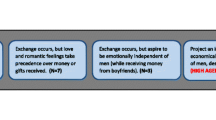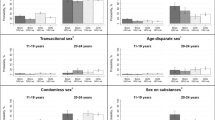Abstract
Transactional sex is associated with incident HIV infection among adolescent girls and young women (AGYW) in sub-Saharan Africa. Evidence on the dimensions of socioeconomic status (SES) which predict transactional sex are mixed and primarily come from cross-sectional studies. This study examined the association between SES and transactional sex in a longitudinal cohort (n = 844) of AGYW ages 15–24 years enrolled in a quasi-experimental study in Lilongwe, Malawi. Prevalence of transactional sex was 22% at baseline, 15% at 6-months and 20% at 12-months. Being divorced or widowed, being food insecure, living in a home without electricity or running water, and having few assets were associated with transactional sex. Higher educational attainment and school enrollment were protective. Having 6–7 socioeconomic risk factors increased odds of transactional sex (AOR = 4.13, 95% CI 2.45, 6.98). Structural interventions which address multiple dimensions of SES may reduce transactional sex and ultimately prevent HIV transmission among AGYW.

Similar content being viewed by others
References
National Statistical Office (NSO) [Malawi] and ICF. Malawi Demographic and Health Survey 2015–16. Zomba, Malawi and Rockville, Maryland, USA: NSO and ICF; 2017
UNAIDS. HIV prevention among adolescent girls and young women: putting HIV prevention among adolescent girls and young women on the Fast-Track and engaging men and boys. Geneva: UNAIDS; 2016.
Jewkes R, Dunkle K. Transactional sex and HIV incidence in a cohort of young women in the stepping stones trial. J AIDS Clin Res. 2012;03:05.
Kilburn K, Ranganathan M, Stoner MCD, Hughes JP, MacPhail C, Agyei Y, et al. Transactional sex and incident HIV infection in a cohort of young women from rural South Africa. AIDS. 2018;32(12):1669–777.
Kudowa E, Chagomerana M, Phanga T, Maseko B, Price JT, Hosseinipour MC et al. Incidence rate and predictors of HIV Incidence among adolescent girls and young women in Lilongwe, Malawi. Mexico City: International AIDS Society Conference; 2019
Wamoyi J, Ranganathan M, Kyegombe N, Stoebenau K. Improving the measurement of transactional sex in sub-Saharan Africa: a critical review. J Acquir Immune Defic Syndr. 2019;80(4):367.
Ankomah A. Premarital sexual relationships in Ghana in the era of AIDS. Health Policy Plan. 1992;7(2):135–43.
Hunter M. The materiality of everyday sex: thinking beyond 'prostitution'. Afr Stud. 2002;61(1):99–120.
Stoebenau K, Heise L, Wamoyi J, Bobrova N. Revisiting the understanding of "transactional sex" in sub-Saharan Africa: a review and synthesis of the literature. Soc Sci Med. 2016;168:186–97.
Kamndaya M, Vearey J, Thomas L, Kabiru CW, Kazembe LN. The role of material deprivation and consumerism in the decisions to engage in transactional sex among young people in the urban slums of Blantyre. Malawi Glob Public Health. 2016;11(3):295–308.
MacPherson EE, Sadalaki J, Njoloma M, Nyongopa V, Nkhwazi L, Mwapasa V, et al. Transactional sex and HIV: understanding the gendered structural drivers of HIV in fishing communities in Southern Malawi. J Int AIDS Soc. 2012;15(Suppl 1):17364.
Okigbo CC, McCarraher DR, Chen M, Pack A. Risk factors for transactional sex among young females in post-conflict Liberia. Afr J Reprod Health. 2014;18(3):133–41.
Moore AM, Biddlecom AE, Zulu EM. Prevalence and meanings of exchange of money or gifts for sex in unmarried adolescent sexual relationships in sub-Saharan Africa. Afr J Reprod Health. 2007;11(3):44–61.
Dunkle KL, Jewkes RK, Brown HC, Gray GE, McIntryre JA, Harlow SD. Transactional sex among women in Soweto, South Africa: prevalence, risk factors and association with HIV infection. Soc Sci Med. 2004;59(8):1581–92.
Greif MJ. Housing, medical, and food deprivation in poor urban contexts: implications for multiple sexual partnerships and transactional sex in Nairobi's slums. Health Place. 2012;18(2):400–7.
Chatterji M, Murray N, London D, Anglewicz P. The factors influencing transactional sex among young men and women in 12 sub-Saharan African countries. Soc Biol. 2005;52(1–2):56–72.
Cluver L, Orkin M, Boyes M, Gardner F, Meinck F. Transactional sex amongst AIDS-orphaned and AIDS-affected adolescents predicted by abuse and extreme poverty. J Acquir Immune Defic Syndr. 2011;58(3):336–43.
Kang M, Dunbar M, Laver S, Padian N. Maternal versus paternal orphans and HIV/STI risk among adolescent girls in Zimbabwe. AIDS Care. 2008;20(2):214–7.
Thurman TR, Brown L, Richter L, Maharaj P, Magnani R. Sexual risk behavior among South African adolescents: is orphan status a factor? AIDS Behav. 2006;10(6):627–35.
Birdthistle IJ, Floyd S, Machingura A, Mudziwapasi N, Gregson S, Glynn JR. From affected to infected? Orphanhood and HIV risk among female adolescents in urban Zimbabwe. AIDS. 2008;22(6):759–66.
Operario D, Underhill K, Chuong C, Cluver L. HIV infection and sexual risk behaviour among youth who have experienced orphanhood: systematic review and meta-analysis. J Int AIDS Soc. 2011;14(1):25.
Malawi National AIDS Commission. Malawi AIDS Response Progress Report Lilongwe, Malawi; 2015.
Rosenberg NE, Bhushan NL, Vansia D, Phanga T, Maseko B, Nthani T, et al. Comparing Youth-Friendly Health Services to the Standard of Care Through “Girl Power-Malawi”: a quasi-experimental cohort study. J Acquir Immune Defic Syndr. 2018;79(4):458–66.
Rosenberg NE, Gichane MW, Vansia D, Phanga T, Bhushan NL, Bekker L-G, et al. Assessing the impact of a small-group behavioral intervention on sexual behaviors among adolescent girls and young women in Lilongwe Malawi: A quasi-experimental cohort study. AIDS Behav. 2019;24:1–9.
Rosenberg NE, Pettifor AE, Myers L, Phanga T, Marcus R, Bhushan NL, et al. Comparing four service delivery models for adolescent girls and young women through the ‘Girl Power’study: protocol for a multisite quasi-experimental cohort study. BMJ Open. 2017;7(12):e018480.
Twisk JW. Applied longitudinal data analysis for epidemiology: a practical guide. Cambridge: Cambridge University Press; 2013.
Choudhry V, Ambresin AE, Nyakato VN, Agardh A. Transactional sex and HIV risks—evidence from a cross-sectional national survey among young people in Uganda. Glob Health Action. 2015;8:27249.
Poulin M. Sex, money, and premarital partnerships in southern Malawi. Soc Sci Med. 2007;65(11):2383–93.
Van de Walle D. Lasting welfare effects of widowhood in a poor country. Washington: The World Bank; 2011.
Reniers G. Divorce and remarriage in rural Malawi. Demogr Res. 2003;1(1):175–206.
Nalugoda F, Guwatudde D, Bwaninka JB, Makumbi FE, Lutalo T, Kagaayi J, et al. Marriage and the risk of incident HIV infection in Rakai. Uganda J Acquir Immune Defic Syndr. 2014;65(1):91–8.
Weiser SD, Leiter K, Bangsberg DR, Butler LM, Percy-de Korte F, Hlanze Z, et al. Food insufficiency is associated with high-risk sexual behavior among women in Botswana and Swaziland. PLOS Med. 2007;4(10):e260.
Gorgens M, Ketende S, Tsododo V, Heard W, Mabuza M, Longosz A, et al. Mexico Sitakhela Likusasa Impact Evaluation: results of a cluster randomized control trial (cRCT) of financial incentives for HIV prevention among adolescent girls and young women (AGYW) in Eswatini. Mexico City: International AIDS Society; 2019.
Cho H, Mbai I, Luseno WK, Hobbs M, Halpern C, Hallfors DD. School support as structural hiv prevention for adolescent orphans in Western Kenya. J Adolesc Health. 2018;62(1):44–51.
De Neve J-W, Fink G, Subramanian SV, Moyo S, Bor J. Length of secondary schooling and risk of HIV infection in Botswana: evidence from a natural experiment. Lancet Glob Health. 2015;3(8):e470–e477477.
Stoner MCD, Edwards JK, Miller WC, Aiello AE, Halpern CT, Julien A, et al. Effect of schooling on age-disparate relationships and number of sexual partners among young women in Rural South Africa enrolled in HPTN 068. J Acquir Immune Defic Syndr. 2017;76(5):e107–e114114.
Jukes M, Simmons S, Bundy D. Education and vulnerability: the role of schools in protecting young women and girls from HIV in southern Africa. AIDS. 2008;22:S41–S56.
Mpoola D, Chanza C, Nankuyu F, Kamela H, Kaunda M, Chirambo A, Kabanga L, Tembo MD, Kamlomo D, Chome J. Malawi: Lilongwe Urban Profile. Nairobi: UN-HABITAT; 2011.
Cluver LD, Orkin FM, Meinck F, Boyes ME, Sherr L. Structural drivers and social protection: mechanisms of HIV risk and HIV prevention for South African adolescents. J Int AIDS Soc. 2016;19(1):20646.
Cluver LD, Orkin FM, Boyes ME, Sherr L. Cash plus care: social protection cumulatively mitigates HIV-risk behaviour among adolescents in South Africa. AIDS. 2014;28(Suppl 3):S389–S397397.
Cluver LD, Orkin FM, Yakubovich AR, Sherr L. Combination social protection for reducing HIV-risk behavior among adolescents in South Africa. J Acquir Immune Defic Syndr. 2016;72(1):96–104.
Toska E, Gittings L, Hodes R, Cluver LD, Govender K, Chademana KE, et al. Resourcing resilience: social protection for HIV prevention amongst children and adolescents in Eastern and Southern Africa. Afr J Reprod Health. 2016;15(2):123–40.
Baird SJ, Garfein RS, McIntosh CT, Ozler B. Effect of a cash transfer programme for schooling on prevalence of HIV and herpes simplex type 2 in Malawi: a cluster randomised trial. Lancet. 2012;379(9823):1320–9.
Boateng GO, Neilands TB, Frongillo EA, Melgar-Quiñonez HR, Young SL. Best practices for developing and validating scales for health, social, and behavioral research: a primer. Front Public Health. 2018;6:149.
Acknowledgements
We would like to thank the District Health Office, the Lighthouse Trust, and Girl Power-Malawi participants and staff for their integral contributions to this study.
Funding
The study was funded by Evidence for HIV Prevention in Southern Africa (EHPSA), a DFID program managed by Mott MacDonald; National Institute of Mental Health [R00 MH104154]; and the National Institute of Allergy and Infectious Diseases [P30 AI50410].
Author information
Authors and Affiliations
Corresponding author
Ethics declarations
Conflict of interest
The authors declare that they have no conflict of interest.
Ethical Approval
All procedures performed in studies involving human participants were in accordance with the ethical standards of the institutional and/or national research committee and with the 1964 Helsinki declaration and its later amendments or comparable ethical standards.
Informed Consent
Informed consent was obtained from all individual participants included in the study.
Additional information
Publisher's Note
Springer Nature remains neutral with regard to jurisdictional claims in published maps and institutional affiliations.
Rights and permissions
About this article
Cite this article
Gichane, M.W., Moracco, K.E., Pettifor, A.E. et al. Socioeconomic Predictors of Transactional Sex in a Cohort of Adolescent Girls and Young Women in Malawi: A Longitudinal Analysis. AIDS Behav 24, 3376–3384 (2020). https://doi.org/10.1007/s10461-020-02910-5
Published:
Issue Date:
DOI: https://doi.org/10.1007/s10461-020-02910-5




